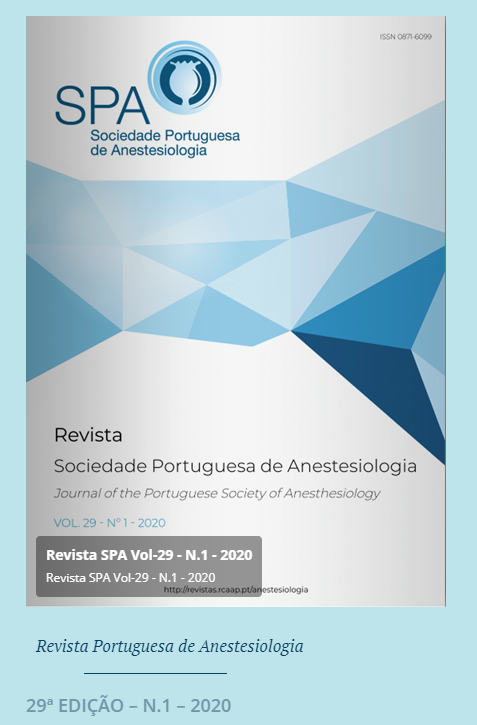Administração de Propofol na Indução da Anestesia Geral em Portugal
DOI:
https://doi.org/10.25751/rspa.18834Keywords:
Anesthesia, General; Anesthesiologists; Anesthetics, Intravenous; Portugal; Propofol; Surveys and QuestionnairesAbstract
Administering propofol intravenously adequately during induction of general anesthesia implies a good knowledge of pharmacokinetics and pharmacodynamics, a good understanding of how anesthesia alters consciousness and the ability to correctly interpret vital signs monitoring. The purpose of this study was to
assess the usual practice of anesthesiologists in Portugal regarding the administration of propofol during the induction of general anesthesia.
A transversal observational analytical and descriptive study, conducted through a questionnaire sent by e-mail to all anesthesiologists of several Portuguese hospitals. The questionnaire presented a conventional scenario (male subject, 50 years, 60 kg, 160cm, ASA I, submitted to general anesthesia with 1% propofol) and
has 10 questions directed to the administration of propofol during induction phase of general anesthesia. A descriptive analysis of the data was performed through SPSS 23.0®.
A total of 118 physicians responded to the survey, most of whom were experts for more than 5 years (56.9%). Based on the presented scenario, most anesthesiologists would administer a propofol dose of 60 mg at induction, at a rate greater than 1200mL/hours, and would assess loss of consciousness by evaluating loss
of the eyelid reflex, which, in BIS index, would be reflected in a 60 value. Most participants measure the patient's blood pressure every 5 minutes and have never used target-controlled infusion systems.
Downloads
References
Portal da Saúde, Mds Portugal. [accessed Feb 2019] Available from: http:www. portaldasaude.pt
Lemos P, Guedes A, Mourão J, Lima JF, Veiga J, Chedas M, et al. 2017 Census: are there enough anaesthesiologists in Portugal?Acta Med Port. 2018; 31: 254–64.
Ghoneim MM. Incidence of and risk factors for awareness during anaesthesia.Best Pract Res Clin Anaesthesiol. 2007; 21: 327–43.
Tarnal V, Vlisides PE, Mashour GA. The neurobiology of anesthetic emergence. J Neurosurg Anesthesiol. 2015; 28: 250–5. doi: 10.1097/ANA.0000000000000212.
Eger EI. Characteristics of anesthetic agents used for induction and maintenance of general anesthesia.Am J Health Syst Pharm. 2004; 61 Suppl 4: S3-10.
Schnider TW, Minto CF, Shafer SL, Gambus PL, Andresen C, Goodale DB, et al. The influence of age on propofol pharmacodynamics. Anesthesiology. 1999; 90: 1502–16.
Diprivan 10 mg/ml (1%) emulsion for injection or infusion - Summary of Product Characteristics (SmPC) - (eMC). [accessed Feb 2019] Available from: https://www.medicines.org.uk/emc/product/5492/smpc
Kazama T, Ikeda K, Morita K, Ikeda T, Kikura M, Sato S. Relation between initial blood distribution volume and propofol induction dose requirement.Anesthesiology. 2001; 94: 205–10.
Adachi YU, Satomoto M, Higuchi H, Watanabe K. The determinants of propofol induction time in anesthesia. Korean J Anesthesiol. 2013; 65: 121.
Blum J, Kochs E, Forster N, Schneider G. The influence of injection rate on the hypnotic effect of propofol during anesthesia: a randomized trial. PLoS Clin Trials. 2006; 1: e17.
Peacock JE, Lewis RP, Reilly CS, Nimmo WS. Effect of different rates of infusion of propofol for induction of anaesthesia in elderly patients.Br J Anaesth. 1990; 65: 346–52.
Ferreira AC, Nunes CS, Castro AI, Ferreira AL, Amorim P. Propofol Requirements for Anesthesia Induction Show Wide Individual Variability, Independently of Age, Gender, Weight and Height. In: Proceedings from the American Society of Anesthesiologists; 2015.
Mashour GA, Shanks A, Tremper KK, Kheterpal S, Turner CR, Ramachandran SK,et al. Prevention of intraoperative awareness with explicit recall in an unselected surgical population: a randomized comparative effectiveness trial. Anesthesiology. 2012; 117: 717–25.
Monk TG, Saini V, Weldon BC, Sigl JC. Anesthetic management and one-year mortality after noncardiac surgery.Anesth Analg. 2005; 100: 4–10.
Lindholm ML, Träff S, Granath F, Greenwald SD, Ekbom A, Lennmarken C, et al. Mortality within 2 years after surgery in relation to low intraoperative bispectral index values and preexisting malignant disease. Anesth Analg. 2009; 108: 508–12.
Chaudhri S, White M, Kenny GN. Induction of anaesthesia with propofol using a
target-controlled infusion system. Anaesthesia. 1992; 47: 551–3.
Absalom AR, Glen JB, Zwart GJ, Schnider TW, Struys MM. Target-controlled infusion:
a mature technology. Anesth Analg. 2016; 122: 70–8.
Downloads
Published
How to Cite
Issue
Section
License
Articles are freely available to be read, downloaded and shared from the time of publication.
The RSPA reserves the right to commercialize the article as an integral part of the journal (in the preparation of reprints, for example). The author should accompany the submission letter with a declaration of copyright transfer for commercial purposes.
Articles are published under the terms of the Creative Commons Attribution Non-Commercial License (CC BY-NC).
After publication in RSPA, authors are allowed to make their articles available in repositories of their home institutions, as long as they always mention where they were published.


